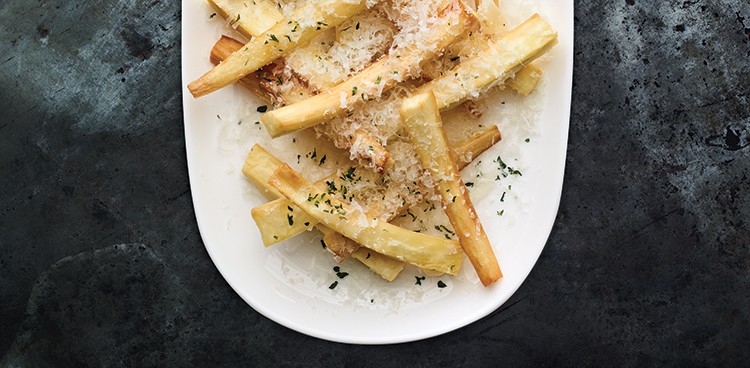
The Great 28 is featured in our Cheese+ 2017 issue. Check out 27 other pairings here.
Let’s be clear: Yuca and yucca are not botanically related. Yuca, also known as cassava, is a native South American plant with an edible root that’s a starchy staple in the Latin American, South Asian, African, and Caribbean culinary diaspora. Yucca, which people often think is the “English” way to spell yuca (thanks, autocorrect!), is a name that applies to as many as 40 species of ornamental, evergreen plants, trees, and shrubs located in the southwest, ranging from decorative garden dwellers to the Joshua tree. While yucca also has edible parts, such as fruit and seeds, its contemporary uses are mostly medicinal.
Yuca’s long, brown, flaky-skinned root with white, waxy flesh is used in hundreds of applications. Ground yuca makes tapioca flour and bubble tea pearls. Like potatoes, yuca roots may be baked, fried, boiled, mashed, and pureed. Unlike potatoes, though, yuca has toxic skin that must be peeled. Since yuca does not come from the nightshade family as potatoes do, those with allergies and sensitivities are free to indulge in this non-inflammatory super-carb—preferably smothered in cheese.
Fried Yuca
With relatively mild flavor and firm structure, yuca roots make stellar chips and fries. Latin American cooks often pair them with garlicky dips or dressings; for instance, Cubans might offer mojo, a potent concoction of olive oil, sour orange juice, garlic, and cumin. To get the same effect with cheese, Michael Love, executive chef of Miami’s renowned Epicure Gourmet Market & Café, suggests sprinkling just-fried yuca chips with a mixture of queso fresco, grated parmesan, and dried parsley.
Or keep it simple and reach for Scandic Priest Cheese XO. Imported from Sweden, this cheese has sharp, dry notes that linger somewhere between aged gouda and clothbound cheddar—its intense flavor profile and flaky texture counter the plain (and potentially greasy) starch beautifully.
Executive chef Miguel Rebolledo, who oversees Florida-based Spanish tapas chain Bulla Gastrobar, also grates cheese over fried yuca. He recommends Manchego Curado, a semi-firm cheese aged three to six months. “The sweet, nutty flavor provides depth,” he says.
Recommended Pairings
Scandic Priest Cheese XO + fried yuca
Queso Manchego PDO + fried yuca
Mashed Yuca
Boiling and mashing yuca is another popular way to serve the root. It’s fairly flavorless, so perk it up with salt and pepper. Better yet: Stir in Queso Paria, a buttery cheese from Peru’s Andes Mountains, recommends Miguel Gomez, executive chef at Pisco y Nazca, a Florida restaurant with two locations. Unless you live in a Latin area, though, Queso Paria may be hard to find. A good alternative: Wisconsin’s Roth Cheese Grand Cru Surchoix, which also has a creamy composition and mushroomy complexity.
Or kick mashed yuca up a notch with Kilchurn Estate Caramelized Onion Cheddar Cheese. One of a few allium-infused English cheddars to hit shelves in recent years (Abbot’s Gold from Wensleydale Creamery is another), Kilchurn Estate offers rich, mild onion flavor and finishes with apple pie notes that don’t eclipse the mash.
Recommended Pairings
Roth Cheese Grand Cru Surchoix + mashed yuca
Kilchurn Estate Caramelized Onion Cheddar Cheese + mashed yuca
Yuca Bread
Yuca bread is made for cheese—literally. Or perhaps we should say with cheese. In Brazil, Colombia, Ecuador, and elsewhere in Latin America, pan de yuca (also called pan de bono and pan de queso, among other names) is a gluten-free treat that combines tapioca flour with queso fresco, egg, milk, baking powder, and salt. The dough is shaped into little balls, frozen for a few minutes, and then baked. The resulting roll has more elasticity than crumb and is simply addictive. If pan de yuca ever lasts a few seconds beyond coming fresh out of the oven, pair it with Quesucos de Liébana, a popular mixed-milk from Rebolleda’s Cantabrian birthplace—then top with fig jelly. Quesuco Ahumado de Liébana is a lightly smoked version from a tiny dairy in the region; the juniper wood over which it’s cured 24 to 36 hours adds a singed-grass flavor that jives well with earthy yuca.
Another option: It might seem out-there to square pan de yuca with Italian blue cheese, but spreading it with dense, dessert-like Verde Capra by Ca de Ambros—made from goat’s milk and aged about as long as Gorgonzola Dolce—is dairy paradise.
Recommended Pairings
Quesucos de Liébana PDO+ yuca bread
Ca de Ambros Verde Capra + yuca bread



